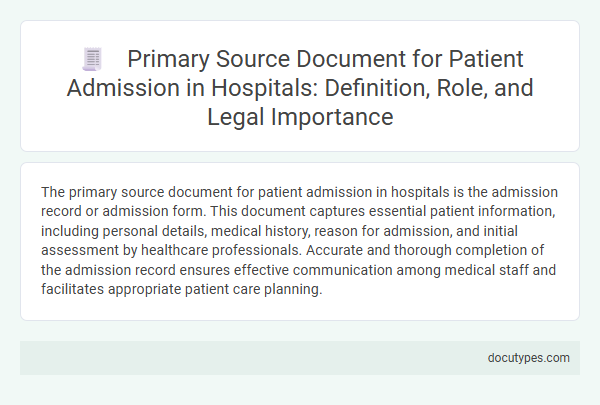The primary source document for patient admission in hospitals is the admission record or admission form. This document captures essential patient information, including personal details, medical history, reason for admission, and initial assessment by healthcare professionals. Accurate and thorough completion of the admission record ensures effective communication among medical staff and facilitates appropriate patient care planning.
Introduction to Primary Source Documents in Patient Admission
Introduction to Primary Source Documents in Patient Admission |
|
|---|---|
| Definition | The primary source document for patient admission in hospitals is the initial medical admission record. This document contains firsthand information collected directly from the patient or provided by the examining healthcare professional. |
| Purpose | It serves as the official record that initiates the patient's hospital stay, capturing essential details such as medical history, presenting symptoms, and initial diagnosis. |
| Components |
|
| Significance | This document establishes the legal and clinical basis for the patient's treatment plan. Accurate and timely documentation is critical for your healthcare continuity and quality assurance. |
| Legal Importance | The primary source document acts as evidence in medical disputes and audits, ensuring accountability for care provided during admission. |
Defining Primary Source Documents in Hospital Settings
The primary source document for patient admission in hospitals is the initial admission record that captures all critical information about the patient. This document serves as the foundational reference for healthcare providers throughout the patient's hospital stay.
Defining primary source documents in hospital settings involves identifying original records created at the point of care that ensure accuracy and reliability of patient data.
- Admission Form - This form includes patient demographics, medical history, and consent details collected upon arrival.
- Physician's Admission Note - A detailed record of the initial clinical assessment and reason for admission written by the attending physician.
- Identification and Insurance Documents - Official records verifying patient identity and coverage status essential for hospital processing and billing.
Types of Primary Source Documents Used During Admission
What is the primary source document for patient admission in hospitals? The primary source document is the Admission Record, which captures critical patient information at the time of entry. It includes personal details, medical history, and initial assessment data.
What types of primary source documents are used during hospital admission? Common documents include the Admission Record, Consent Forms, Medical History Forms, and Insurance Information Sheets. These documents ensure accurate patient identification and facilitate proper care planning.
How does the Admission Record benefit your hospital stay? This document provides healthcare providers with essential information about your medical background and current condition. It supports timely decision-making and coordinated treatment efforts.
Essential Components of Admission Documentation
The primary source document for patient admission in hospitals is the Admission Note or Admission Record. Essential components of admission documentation include patient identification details, medical history, reason for admission, and initial clinical assessment. Your accurate and complete admission note ensures effective communication among healthcare providers and supports quality patient care throughout the hospital stay.
The Role of Admission Documents in Patient Care Continuity
The primary source document for patient admission in hospitals is the admission form or admission record. This document captures essential patient information, medical history, and initial clinical assessments.
Admission documents play a crucial role in ensuring continuity of patient care by providing accurate and timely data to healthcare professionals. They facilitate coordinated treatment plans, reduce errors, and enhance communication among multidisciplinary teams.
Legal Significance of Primary Source Documents
The primary source document for patient admission in hospitals is the admission record or intake form. These documents provide the initial and most accurate information regarding a patient's condition and consent for treatment.
- Legal Evidence - Admission records serve as crucial legal evidence in case of disputes or malpractice claims by documenting the patient's consent and initial health status.
- Accountability - They establish accountability for healthcare providers, ensuring that proper procedures and protocols were followed during admission.
- Continuity of Care - Primary source documents support continuity of care by providing reliable baseline information for all future medical decisions and treatments.
Your hospital admission document is vital for both your legal protection and the accuracy of your medical care.
Compliance Standards for Admission Documentation
The primary source document for patient admission in hospitals is the Admission Record or Admission Note. This document captures essential patient information required for medical, legal, and administrative purposes.
Compliance standards for admission documentation include accuracy, completeness, and timely entry of patient data. Your adherence to these standards ensures proper patient care and legal protection for the healthcare facility.
Challenges in Managing Admission Documents
The primary source document for patient admission in hospitals is the admission record or admission form. This document captures essential patient information such as personal details, medical history, and reason for admission.
Managing admission documents presents several challenges, including accurate data entry, document security, and timely availability for clinical staff. Incomplete or incorrect information can lead to medical errors and delays in patient care. Hospitals must implement efficient document management systems to ensure compliance with regulatory standards and enhance patient safety.
Best Practices for Accurate Patient Admission Records
The primary source document for patient admission in hospitals is the Admission Record or Admission Form. This essential document captures critical patient information such as personal details, medical history, and reason for hospitalization. Best practices include accurate data entry, verification of patient identity, and timely updates to ensure comprehensive and reliable admission records.
What Is the Primary Source Document for Patient Admission in Hospitals? Infographic

